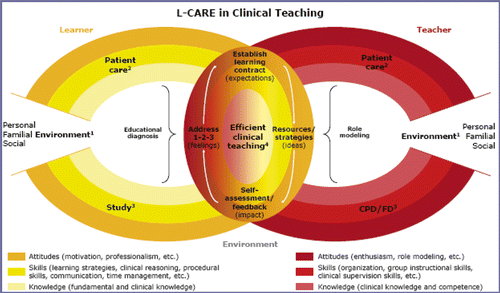Figures & data
Table 1. Educational diagnosis and management of challenging learners
Figure 1. Grow's stages of self-directed learning. Notes: The teacher's role is to guide learners through the improvement of their self-direction skills, learned through different stages: at first, the learner is dependent, then becomes interested, involved and finally self-directed. Teachers should take care to matching their teaching style to the learners’ stage of self-directedness, and progressively decrease their responsibility towards learning (move from being expert to motivator, facilitator and ultimately consultant). Illustrative diagram inspired from Grow (Grow Citation1991).

Table 2. Efficient teaching strategies
Figure 2. Learner-Centered Approach to Raise Efficiency (L-CARE) in Clinical Teaching. The L-CARE in clinical teaching model illustrates the encounter of a learner and teacher in their personal and professional context, when they both have personal, familial and social environment (1) needs and concerns. Above and beyond, the professional environment is largely devoted to patient care (2) and study time (3) (or continuing professional development/faculty development and administrative duties). Teaching (4) has to find its place in this mutually dense schedule. In this model, the learner is illustrated with the left circle and the teacher is represented on the right. The concentric shapes represent the required attitudes, skills and knowledge for both members. The learner and teacher circles are overlapped to create the teaching environment. The central cycle illustrates the learner-centered approach in self-directed learning. CPD/FD: continuing professional development/faculty development.

